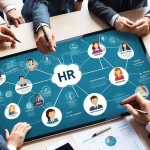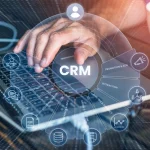Blog
Beyond Payroll: How Human Resource Software Companies Are Redefining Employee Experience
For a long time, HR software was seen as little more than a tool to process payroll, mark attendance, and store employee records. But times have changed. The workplace itself has changed. And so have the expectations of both employees and employers.
Today, human resource software companies are reshaping what it means to manage people — shifting from pure administration to building a more connected, motivated, and productive workforce. It’s no longer about tracking data; it’s about understanding people.

The New Role of HR Technology
Modern HR software isn’t built just for HR teams anymore. It’s designed for everyone — from hiring managers and team leads to employees who expect seamless, digital-first experiences.
The new generation of human resource software companies focuses on employee experience: how people engage with their work, how managers support them, and how businesses can make smarter decisions using data.
Automation is just the foundation. What truly sets leading HR software apart today is its ability to bring empathy and insight into digital processes.
From Paperwork to People: The Real Transformation
Let’s face it — HR used to be synonymous with paperwork. Manual data entry, endless spreadsheets, and administrative backlogs made it difficult for HR professionals to focus on people.
That’s no longer the case.
Now, cloud-based HR platforms handle everything — from onboarding and payroll to feedback and performance reviews — while freeing HR teams to focus on what truly matters: employee growth and engagement.
The human resource software companies leading this shift are those that blend simplicity, intelligence, and personalization into every part of the employee lifecycle.
How Modern HR Software Solves Real-World Challenges
1. Retention in a High-Turnover World
Retaining talent is one of the hardest challenges HR teams face today. People don’t stay just for paychecks anymore — they stay for growth, flexibility, and belonging.
Modern HR software helps organizations track engagement trends, analyze turnover risks, and even predict when employees might be ready for a new challenge. It allows HR leaders to take preventive action before problems escalate.
For example, automated surveys can measure employee sentiment, while dashboards reveal early warning signs like performance drops or reduced collaboration.
2. Managing Remote and Hybrid Teams
Hybrid work is here to stay. Yet, managing people you rarely see in person comes with its own challenges — visibility, communication, and alignment.
The latest HR systems enable clear performance tracking without compromising trust. Real-time feedback tools, integrated communication apps, and analytics dashboards allow managers to measure outcomes instead of just hours logged.
It’s about enabling flexibility while keeping teams connected and motivated.
3. Ensuring Compliance and Data Security
As teams grow and expand globally, HR compliance becomes increasingly complex. Labor laws, tax structures, and privacy regulations differ from one region to another.
That’s why leading human resource software companies are investing heavily in compliance automation and data protection. From secure payroll processing to GDPR-aligned data storage, modern HR tools ensure both accuracy and accountability — so organizations can focus on their people, not their paperwork.
4. Encouraging Continuous Learning
The best HR systems now include built-in learning management features. Employees can explore online training modules, get AI-based recommendations for courses, and even track their skill progress over time.
This shift toward continuous learning has made it easier for organizations to reskill teams and keep pace with changing market demands — without needing multiple platforms or manual tracking.
AI and Analytics: The Smart Backbone of HR
Artificial intelligence has become the quiet powerhouse behind most HR decisions today.
- In recruitment, AI algorithms analyze candidate profiles to identify the best matches faster.
- In performance management, analytics highlight trends in productivity, morale, and growth potential.
- In engagement, machine learning helps personalize communication and wellness initiatives.
Instead of replacing human judgment, AI enhances it. The result? Faster hiring, smarter planning, and a workplace that adapts in real time.
That’s the edge that top human resource software companies bring to the table — insight, not just information.
Why Choosing the Right HR Partner Matters
Every company’s HR needs are unique. A growing startup doesn’t need the same software as a multinational enterprise.
Before selecting an HR technology partner, it’s important to look beyond flashy dashboards and check whether the system:
- Scales with your workforce
- Integrates with existing tools like payroll or CRM
- Provides strong data security and local compliance
- Offers accessible support and user-friendly design
The best human resource software companies act not as vendors but as partners — helping organizations design workflows that fit their culture and goals.
The Human Element That Technology Can’t Replace
Even the most advanced software cannot replace empathy, recognition, and trust — the real foundation of HR. Technology should amplify these values, not overshadow them.
That’s why the future of HR software isn’t just about automation; it’s about balance. Automation handles the repetitive, while people handle the meaningful.
Modern HR technology gives organizations time back — time to talk to employees, listen to their challenges, and shape better workplaces.
Looking Ahead: What’s Next for HR Software
The next evolution in HR tech will likely focus on predictive insights — systems that don’t just track what’s happening but forecast what could happen.
Imagine knowing which teams are at risk of burnout before it occurs, or identifying the perfect internal candidate for a new role through skills-based AI. These advancements are already in motion, and human resource software companies are leading the charge.
As HR continues to move from process-driven to people-centric, technology will play an even more crucial role — not to replace the human touch but to enhance it.
Druvo’s Perspective: Human-First, Tech-Enabled
At Druvo, we believe HR software should simplify, not complicate. Our mission is to help organizations spend less time managing systems and more time nurturing people.
By blending automation with empathy, Druvo empowers HR teams to make smarter decisions, ensure compliance, and elevate employee experience — all within one unified platform.
It’s not just about HR management anymore. It’s about enabling human potential.
Frequently Asked Questions
- What do human resource software companies do?
They build digital platforms that help businesses automate HR processes — including payroll, onboarding, performance management, and employee engagement.
- How do HR software companies improve retention?
By analyzing engagement data, tracking employee sentiment, and highlighting early signs of dissatisfaction, enabling HR teams to respond proactively.
- Are HR software tools suitable for hybrid teams?
Yes. Most modern HR systems are cloud-based, offering real-time access and collaboration for remote and in-office employees alike.
- Why is data security essential in HR software?
HR systems handle sensitive employee data like salaries, IDs, and performance. Strong encryption and access controls ensure compliance and protect privacy.
- How is Druvo different from other HR software companies?
Druvo focuses on blending human-first design with automation. It streamlines HR operations while creating personalized experiences for employees at every stage.




